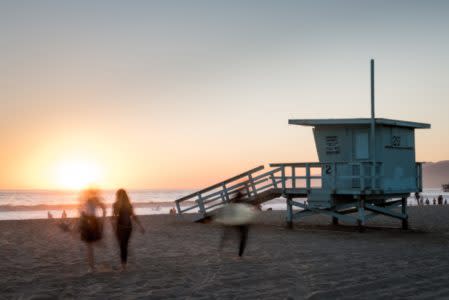The Black & Blue History Of Bruce's Beach

Since emancipation, Black Americans have been the victim of mass land robberies by White Americans and the US government. The issue really ramped up after the 1950s. Black farmers and land owners were stripped of their land across the country. This is what happened at Bruce’s Beach.
While most think of farmers in the South, a Black family in Manhattan Beach, CA also experienced the same systematic evil depriving them of generational wealth. Over a century ago, Charles and Willa Bruce’s family was run out of their beachfront property by whites living around the area. Along with them left a thriving, Black community at Bruce’s Beach.
On July 20, Los Angeles County approved the decision to return the Bruce’s land to the family’s rightful heirs. This decision comes two years after Los Angeles County Supervisor Janice Hahn launched an investigation into the land being stolen.
Hahn gathered at the oceanfront on Bruce’s Beach to publicly returned the land to Anthony and Derrick Bruce. The decision was the first time in US history that the government returned land wrongfully taken from a Black family.
The historic motion at Bruce’s Beach is a game changer for Black Americans. Over the past century, African-Americans have lost millions of acres of farmland due to systematic racism and oppression barriers. And that’s only in the South. A landmark decision, Bruce’s Beach may be the beginning of Black families across America inheriting what is rightfully theirs.
The Great Land Robbery

Kelly.
In his 2019 article for The Atlantic titled The Great Land Robbery, journalist Vann Newkirk detailed a long history of racism and economic oppression that led to Black farmers being pushed off millions of acres of farmland in the South.
The trend wasn’t new.
Newkirk described how in the 20th century, federally funded farm programs intentionally excluded Black farmers. The programs aimed to keep them disenfranchised by denying their loans and bullying them off their land.
Boards in the South would also threaten not to grant loans and funds to Black farmers if they voted or joined the NAACP. Fear tactics and racism were reinforced throughout the South and more Black farmers were forced from their homes. Many exited the southern states during the Great Migration.
Newkirk spoke with dozens of Black farm families who’d both lost and retained their land. One woman said what mattered most to her was the history that was stolen from her family. The history was stolen with the land.
“That’s a thing that I do not believe we quite understand,” Newkirk told PBS News Hour. “It’s lost when people are forced to move, when they are denied the ability to own the land under their feet. They’re denied a bit of their history.”
Like Black Southern farmers, the families at Bruce’s Beach endured the same hardship. What was once a growing, Black shoreside community was beaten down and harassed into exile by white community members. While the return of the beach sets a new precedent for Black land owners, it doesn’t erase the longstanding history of wrongdoing they have suffered at the hands of White Americans.
A History Of Racism At Bruce’s Beach

Charles and Willa Bruce moved to Manhattan, CA in 1912 and purchased a prime beachside property. It sat on the ancestral lands of the Tongva people and had been claimed by white developers. The pair opened a lemonade and hotdog stand. Eventually, it expanded to a lodge, cafe, and dance hall that welcomed Black travelers.
As time went on, more Black families were attracted to Bruce’s Beach. They bought cottages along the shore and a small community began to develop. However, word started to circulate among their white neighbors and many didn’t like more people of color living in Manhattan Beach.
The Bruce’s and other Black families faced regular threats and harassment from their white neighbors, the local police, and the Ku Klux Klan. When the threats didn’t work, city officials condemned the neighborhood in 1924 along with over a dozen other Black-owned properties. They wanted to seize the neighborhood by any means necessary and, with the sudden urgent need for a public park, the city took over Bruce’s Beach.
Ironically, the beach sat empty for decades. The city finally built the park that was “urgently” needed in 1956. Ownership of the beach bounced between the state and the county until it was secured by Los Angeles County in 1995.
The Return Of Black Ownership
Once Hahn realize Los Angeles County owned portions of the land previously occupied by the Bruce’s resort, she immediately sprung into action. She worked with Supervisor Holly Mitchell and Senator Bradford to encourage lawmakers to transfer the land owned by the county back to the Bruce family.
“We can’t change the past, and we will never be able to make up for the injustice that was done to your great-great-grandparents and great-grandparents Willa and Charles nearly a century ago,” Hahn told the Bruce family. “But this is a start.”
To reacquire the land, the Bruce family was assisted by real estate transaction lawyer George Fatheree. The attorney represented them pro bono and helped the family overcome legal challenges, conduct genealogy testing, and analyze complicated economic breakdowns to determine the value of the land.
Moving forward, Los Angeles County will rent the beach property from the Bruce family for $413,000 each year. The new plan allows the county to house its lifeguard facility on the beach and leaves the door open for them to purchase the land from the Bruce Family in the future for $20 million.
Kavon Ward, the leader behind the grassroots organization Justice for Bruce’s Beach, believes this is just the beginning of Black and Indigenous people taking back ownership of stolen land. Ward is currently helping five other families in California reclaim land and says this is a turning point in American history.
“This solidifies that what was once impossible is now possible,” Ward told the LA Times. “It confirms that people have a right to have this much audacious hope and vision. … I am looking forward to many more days where we correct the harm that was done.”
The return of Bruce’s Beach to its true owners opens a Pandora’s box of questions about Black ownership in America. Another example of the injustice, oppression, and systematic harm that rages throughout the nation’s history, many hope this change will cause a ripple effect that returns generational wealth to the Black community.

